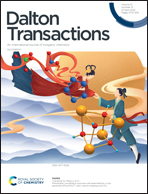Probing the hydrolytic degradation of UF4 in humid air†
Abstract
This manuscript describes the chemical transformations that occur during hydrolysis of uranium tetrafluoride (UF4) due to its storage in humid air (85% and 50% relative humidity) at ambient temperatures. This hydrolysis was previously reported to proceed slowly or not at all (depending on the percent relative humidity); however, previous reports relied primarily on X-ray diffraction methods to probe uranium speciation. In our report, we employ a battery of physiochemical probing techniques to explore potential hydrolysis, including Raman spectroscopy, powder X-ray diffraction, 19F nuclear magnetic resonance spectroscopy, scanning electron microscopy, and focused ion beam microscopy with energy-dispersive X-ray spectroscopy. Of these, only Raman spectroscopy proved to be particularly useful at observing chemical changes to UF4. It was found that anhydrous UF4 slightly oxidizes over the course of thirteen days to Schoepite-like uranium complexes and possibly UO3. In contrast, UF4 exposed to 50% relative humidity slightly decomposes into UO2F2, Schoepite-like uranium complexes, and possibly a high order uranium oxide that eluded chemical assignment (UxOy). Despite the rich chemical speciation observed in our Raman spectroscopy measurements, X-ray diffraction and 19F NMR measurements on the same material showed no changes. Microscopy measurements suggest that the observed reactions between UF4 and water occur primarily on the surface of UF4 particulates via a method that is visually similar to surface corrosion of metals. Therefore, we postulate that NMR spectroscopy and X-ray diffraction, which are well-suited for bulk analysis, are less suited than Raman spectroscopy to observe the surface-based reactions that occur to UF4 when exposed to humid air. Considering the importance of UF4 in the production of nuclear fuel and weapons, the results presented herein are widely applicable to numerous nuclear science fields where uranium detection and speciation in humid environments is of value, including nuclear nonproliferation and nuclear forensics.



 Please wait while we load your content...
Please wait while we load your content...
